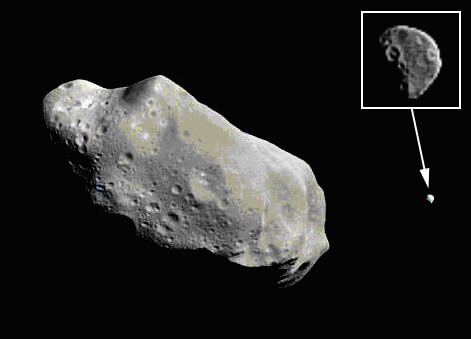In recent years it became clear that even asteroids, despite their tiny size, can have moons. In this article we will provide an updated list

Asteroids that have moons have only been observed in the last few decades. The first time this phenomenon was observed was when the Galileo spacecraft that was on its way to Jupiter passed by the asteroid Ida on August 28.8.1993, 52 and detected a tiny moon orbiting it. The moon was named Ductyl. The asteroid is 23 km long and 100 km wide. "M. Its moon is 1.4 km away from it, its dimensions are 1.2X1.6X300 km. It also has craters and the largest ones are 4 meters in diameter. The asteroid is reddish and made of a mixture of iron and the minerals found on it are pyroxene and olivine. It is revolves around itself once in 38 hours and 1,2 minutes (XNUMX).Telescopic observations in later years with more sophisticated equipment discovered several more asteroids with moons and they are:
1. Eugenia - an asteroid that is 134 km long and is surrounded by a moon that is 13 km long. The distance of the moon from it is 2000 km and it circles it once in 4.5 days. Eugenia is 300 times brighter than its moon and its density is 1.2 g/cc. According to the information known today, asteroids are made of rocky material and it is not clear why the density of this asteroid is low. Two possibilities have been put forward to explain the phenomenon. According to one explanation, the asteroid is made mostly of water. It is known from studies that only comets that have lost a lot of material, their density is so low. The problem with this explanation is that the orbit of active comets is different from the orbit of asteroids and it is not understood how a comet ends its life in an orbit that is not typical for comets. According to the second explanation, Eugenia is actually a pile of porous rock fragments. In such a pile there will be large spaces between the rocks to "produce" such a low density and it is not clear if this is even possible (3,4).
2. Pulcova - an asteroid with a length of 144 km and a moon with a length of 14.4 km located 800 km away from it and orbiting it once every 4 days. The density of Pulcova is close to that of water ice (5).
3. Antiope - two egg-shaped asteroids 86 km long each orbiting each other at a distance of 171 km from each other. It is estimated that they originate from an asteroid that disintegrated 2.5 million years ago as a result of a hit from another asteroid. They orbit each other once every 16.5 days and their density is 1.25 g/cm6 (XNUMX).
4. Sylvia - an asteroid that is 280 km long, has a density of 1.2 g/cm5 and rotates around its axis once every 7 hours. It is made of hydrated carbonate chondritic materials and has two moons. One moon named Remus is 710 km long and 33 km from Sylvia and orbits it once in 18 hours. The second moon was named Romulus, its length is 1360 km, its distance is 87.6 km and it circles it once XNUMX km.
5. 2001 SN263- a spherical body with a diameter of 2 km which has two moons. One moon with a diameter of 1 km and the other moon with a diameter of 0.3 km (8).
6. Minerva - an asteroid that is 150 km long and is dark and probably made of carbonates. It has two small moons, one 4 km long located 630 km away from it and the other 3 km long and 380 km away (9).
Where do they get these asteroids and moons from? To answer this question it is necessary to understand that the orbits of most asteroids are chaotic and sometimes they collide with each other and crush each other. Parts of the broken asteroids are splashed everywhere and can also enter orbit around the Sun and become asteroids themselves or the acceleration they gain takes them out of the asteroid belt and into orbit around the gas planets. Let's not forget that these planets have dozens of tiny moons that are tens of kilometers long or less. Tiny fragments that failed to escape, entered orbit around the asteroids from which they were broken. The routes are not necessarily stable. It is also possible that the chaotic orbits of the asteroids will bring them into collision with the small moons and take them out of their orbit and maybe they will continue to break up and over the course of tens of millions of years will turn them into clouds of dust.
These asteroids can be defined as mini-planetary systems. It is appropriate to establish teams of researchers who will try to hunt for more such asteroids. This can be done from Earth, from space telescopes and from a future telescope that will be built on the moon.
Sources
1. “Ida rotation” – Spaceflight Vol.. 36 November 1994 p.385
2. "Ida Moon"- Spaceflight Vol.. 36 November 1994 p.385
3. Zubarenko D. - "Tiny moon found rotating asteroid" 6.10.1999
http://dailynews.yahoo.com/h(nm)19991006/sc/space_asterod_2.html
4. Clark G. – “Astronomers find moon orbiting asteroid” 6.10.1999
http:// www.spacecom/news/eugenia-moon991006.html
5. "Asteroid portfolio gets a boost with new optics" 26.10.2000
http://www.spacedaily.com/news/asteroid-00r.html
6. "Amateur and professional astronomers combine observations produce double asteroid image" 30.3.2007
http://www/spacedaily.com/reports/ Amateur_ And _Professional_ Astronomers _Combine _Observations _Produce_ Double_ Asteroid_ image_999.html
7. "First triple asteroid system found" 11.8.2006
http://www/spacedaily.com/news/asteroid-05.html
8. Fridlander BP Junior- "Arecibico observatory astronomers discover first Near Earth Asteroid" 15.2.2008
http://www/spacedaily.com/reports/ Arecibico _ Observatory _Astronomers_ Discover _first_ Near _Earth _Asteroid_999.html
9. 93 Minerva
http://wikipedia.org/wiki/93_ Minerva
